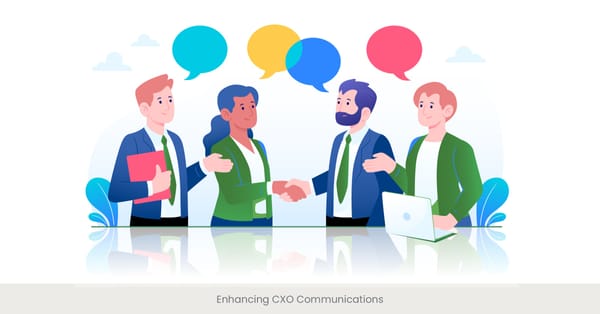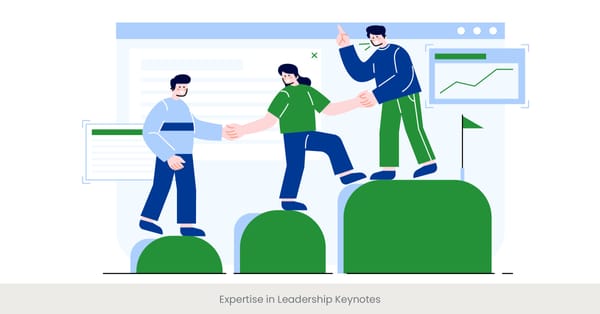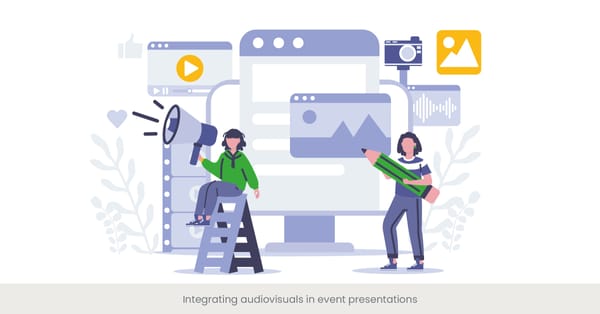
Discussing the Impact of High-Quality Video Content on Audience Engagement
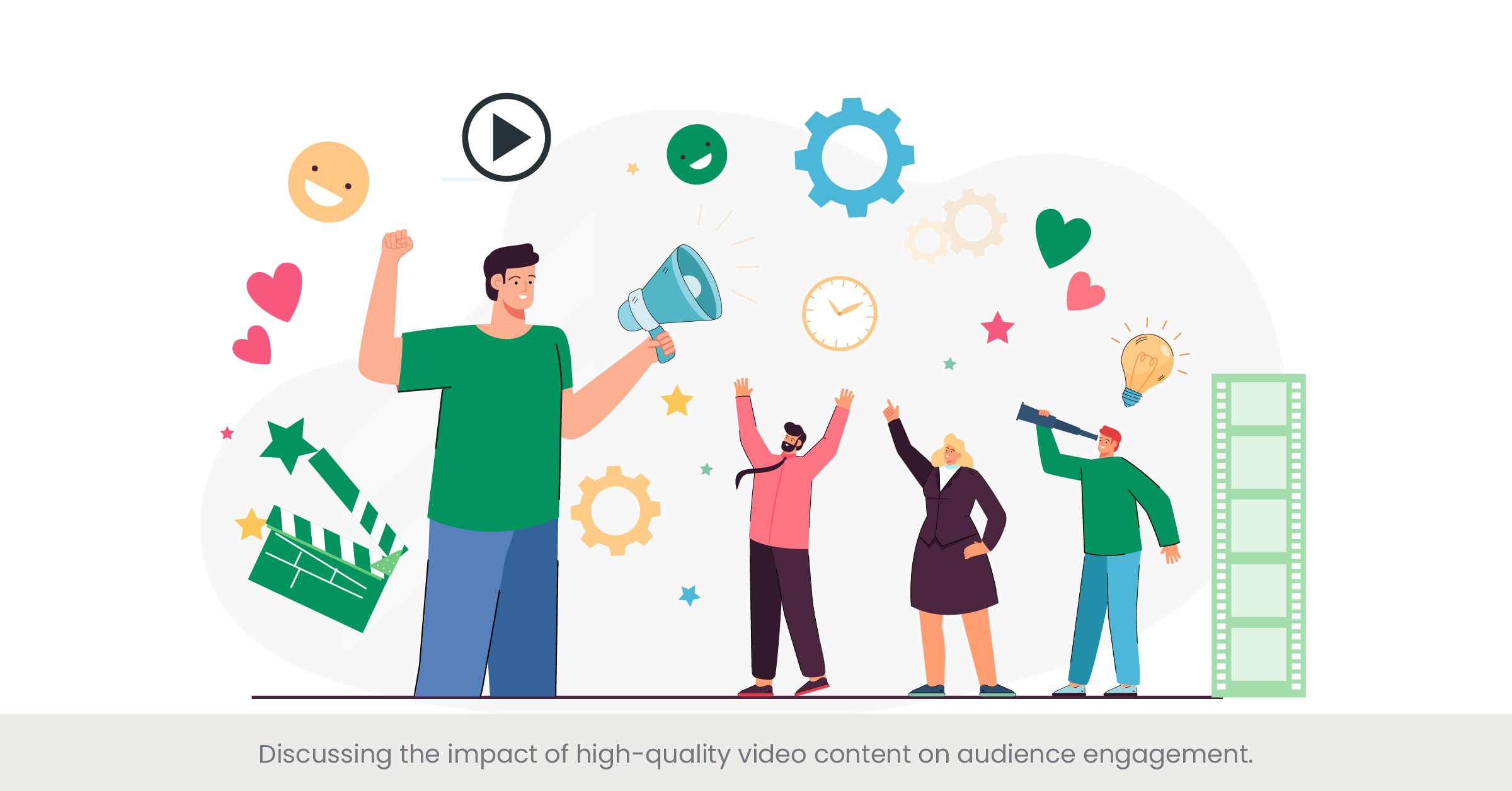
The Power of High-Quality Video Content
High-quality video content plays a crucial role in enhancing audience engagement during leadership presentations. When crafted effectively, video content can capture the audience’s attention, convey complex information succinctly, and create a lasting impression. CEO Audio Visual Content, when used appropriately, helps in illustrating points more vividly and making the overall presentation more dynamic. As businesses and marketing strategies evolve, integrating high-quality video content has become a fundamental part of engaging and retaining the audience's interest during presentations.
The Mechanics Behind Video Content Engagement
The effectiveness of video content lies in its ability to combine visual and auditory stimuli, which enhances information retention and engagement. High-definition visuals paired with clear, professional audio create an immersive experience for the audience. According to psychological studies, people are more likely to remember information presented in a multimedia format compared to text alone. This is because video content appeals to multiple senses, making it easier for the audience to understand and retain the presented information. Professional video content can be used to introduce new concepts, showcase products, or provide real-world examples, all of which contribute to a more engaging and memorable presentation.
Real-World Examples and Applications
Several successful companies leverage high-quality video content in their leadership presentations to great effect. For instance, Apple Inc. is renowned for its use of slick, professionally produced videos during product launches and keynote presentations. These videos not only showcase the features and benefits of new products but also tell a compelling story that resonates with the audience. Another example is Tesla, which uses high-quality videos to demonstrate the capabilities of their vehicles, including safety features and autonomous driving technology. These videos enhance the overall presentation by providing clear, visual evidence of the company’s innovations and commitments.
References and Supporting Evidence
Research supports the significant impact of high-quality video content on audience engagement. A report by HubSpot indicates that 54% of consumers prefer to wait less to see video content from brands they support, and 72% of customers would rather learn about a product or service through video. Furthermore, a study by Cisco predicts that video will make up 82% of all internet traffic by 2022, underscoring its growing importance in digital communication. These statistics highlight the effectiveness of incorporating high-quality video content into presentations, emphasizing the need for companies to invest in professional audio visual resources.
Integrating Professional Audio Elements for a Polished Presentation
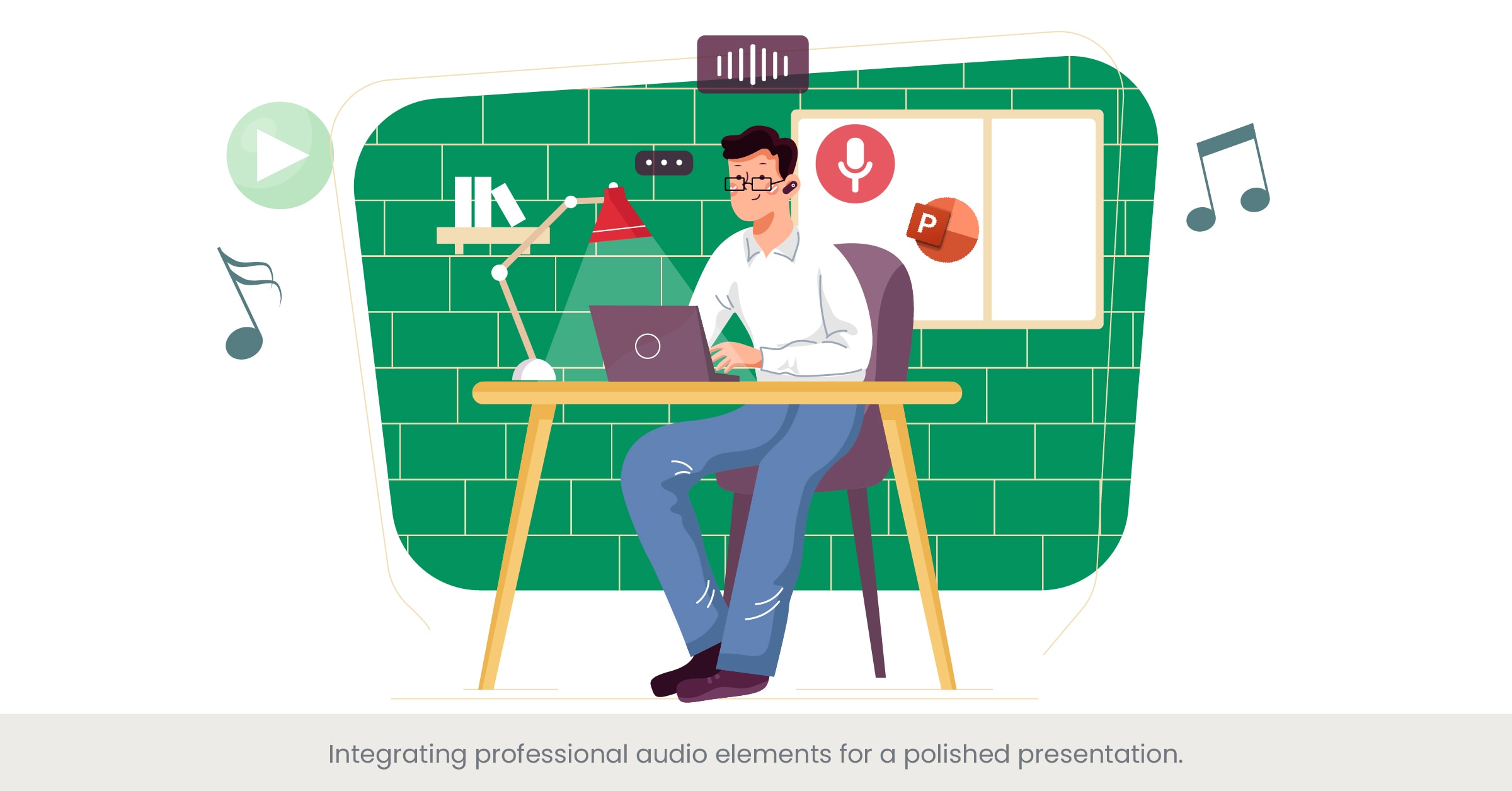
Enhancing Presentations with Professional Audio
Integrating professional audio elements into leadership presentations is essential for delivering a polished and engaging experience. High-quality audio ensures that the audience can clearly hear and understand the content being presented, which is crucial for maintaining attention and conveying messages effectively. CEO Audio Visual Content benefits significantly from well-produced audio, as it adds a layer of professionalism and clarity that can elevate the entire presentation. In the realm of business and marketing, clear and crisp audio can make a substantial difference in how the presentation is received and remembered.
The Mechanics of Professional Audio Integration
Professional audio integration involves using high-quality microphones, sound mixing, and audio editing to ensure that every spoken word is clear and free from distortion or background noise. This process starts with selecting the right equipment, such as lapel mics for individual speakers or boundary mics for group discussions, which are designed to capture sound accurately. Additionally, audio editing software can be used to enhance the clarity and consistency of the audio track, removing any unwanted noise and balancing sound levels. Integrating these elements helps create a seamless audio experience that keeps the audience engaged and focused on the presentation content.
Practical Applications and Real-World Examples
Real-world examples highlight the importance of professional audio in leadership presentations. For instance, during high-profile events like Apple's WWDC or Google's I/O conferences, professional audio setups ensure that every word spoken by the presenters is heard clearly by both live and remote audiences. These companies use top-tier audio equipment and sound engineers to maintain the highest standards of audio quality. Another example is TED Talks, where the quality of audio is paramount to the success of the presentations. High-quality audio ensures that the powerful messages delivered by speakers are clearly heard and appreciated by global audiences.
References and Supporting Evidence
Research underscores the importance of professional audio in enhancing presentation effectiveness. According to a study by TechSmith, 75% of users said they would stop watching a video if the audio quality was poor, even if the video quality was acceptable. Furthermore, a report by the Journal of the Audio Engineering Society highlights that high-quality audio can significantly improve the audience's ability to understand and retain information. These findings validate the necessity of integrating professional audio elements into presentations, emphasizing the role of a COO Presentation Design Expert in achieving this goal.
Techniques for Synchronizing Visuals and Audio to Enhance Messaging
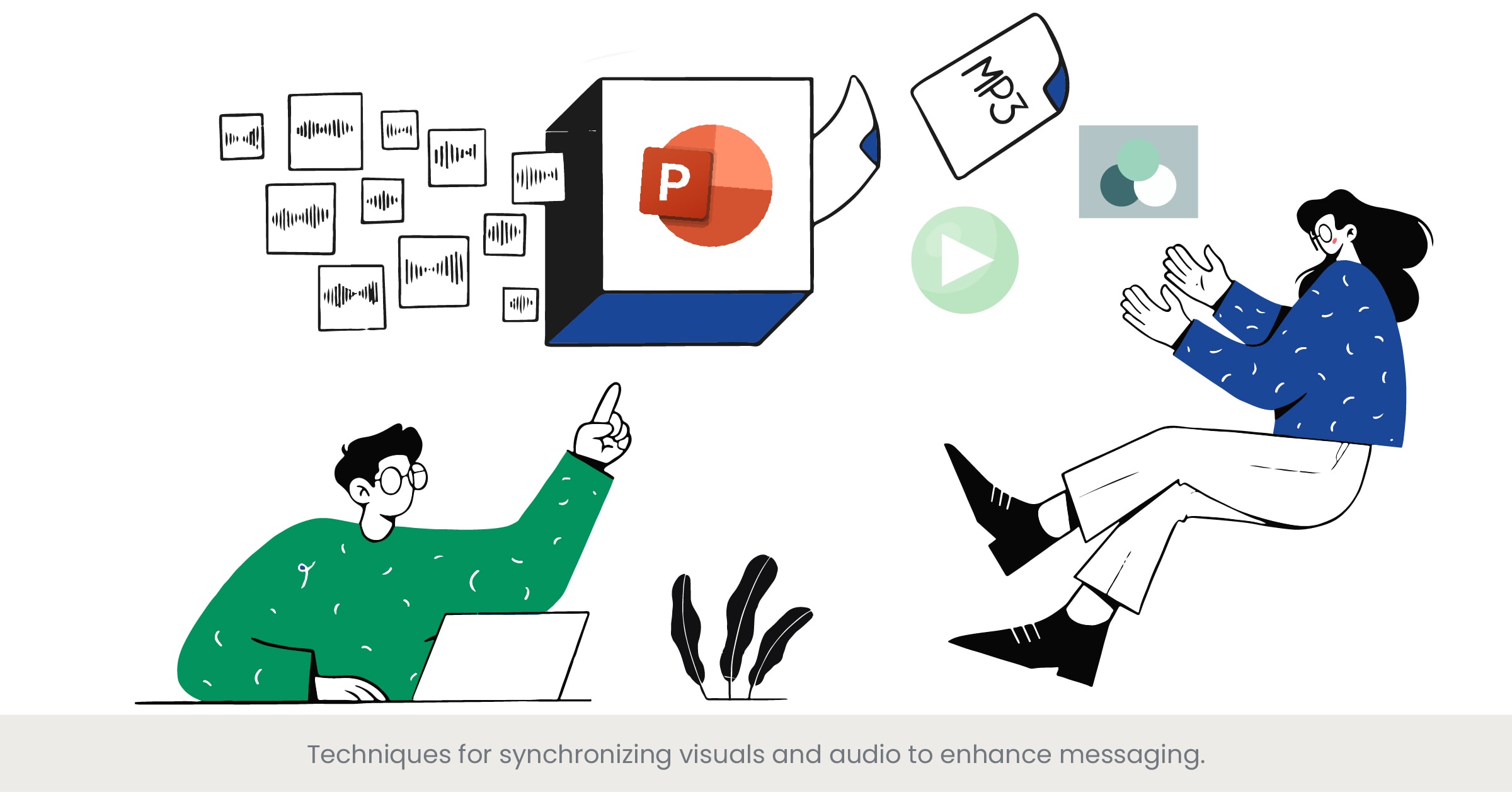
The Synergy of Visuals and Audio in Presentations
Synchronizing visuals and audio is a powerful technique for enhancing the messaging in leadership presentations. When done effectively, this combination can significantly improve the audience's engagement and comprehension. CEO Audio Visual Content strategy that seamlessly integrates visuals and audio ensures that the message is communicated clearly and memorably. This technique is particularly crucial in business and marketing contexts, where the alignment of visual and auditory elements can help convey complex ideas more effectively.
The Mechanics of Synchronization
The process of synchronizing visuals and audio involves careful planning and execution. It starts with scripting the presentation to ensure that visual elements align with the audio narrative. This means that each visual cue, such as a slide change or animation, is timed perfectly with the corresponding audio commentary. Tools like video editing software can be used to fine-tune this synchronization, ensuring that transitions are smooth and natural. Professional presentation services often employ techniques like storyboarding to map out the entire presentation, highlighting where and how visuals and audio will intersect to maximize impact.
Practical Applications and Real-World Examples
Successful companies often use synchronized visuals and audio to enhance their leadership presentations. For example, Microsoft uses synchronized demo videos and live narration during product launches to showcase software features effectively. This approach helps the audience understand how the software works in real-time, making the presentation more interactive and engaging. Another example is in educational webinars, where speakers use synchronized slides and audio explanations to teach complex subjects. This method helps break down the information into manageable segments, making it easier for the audience to follow along and retain the information presented.
References and Supporting Evidence
Research supports the idea of the effectiveness of synchronizing visuals and audio in presentations. A study by the University of Iowa found that multimedia presentations that align visuals and audio improve information retention by up to 50%. Additionally, a report by the National Training Laboratories indicates that combining visual and auditory learning increases retention rates by 65%. These findings emphasize the importance of this technique in COO presentations, highlighting the role of a COO Presentation Design Expert in ensuring that visuals and audio are perfectly synchronized.
Highlighting Successful Case Studies of AV Integration in Leadership Events
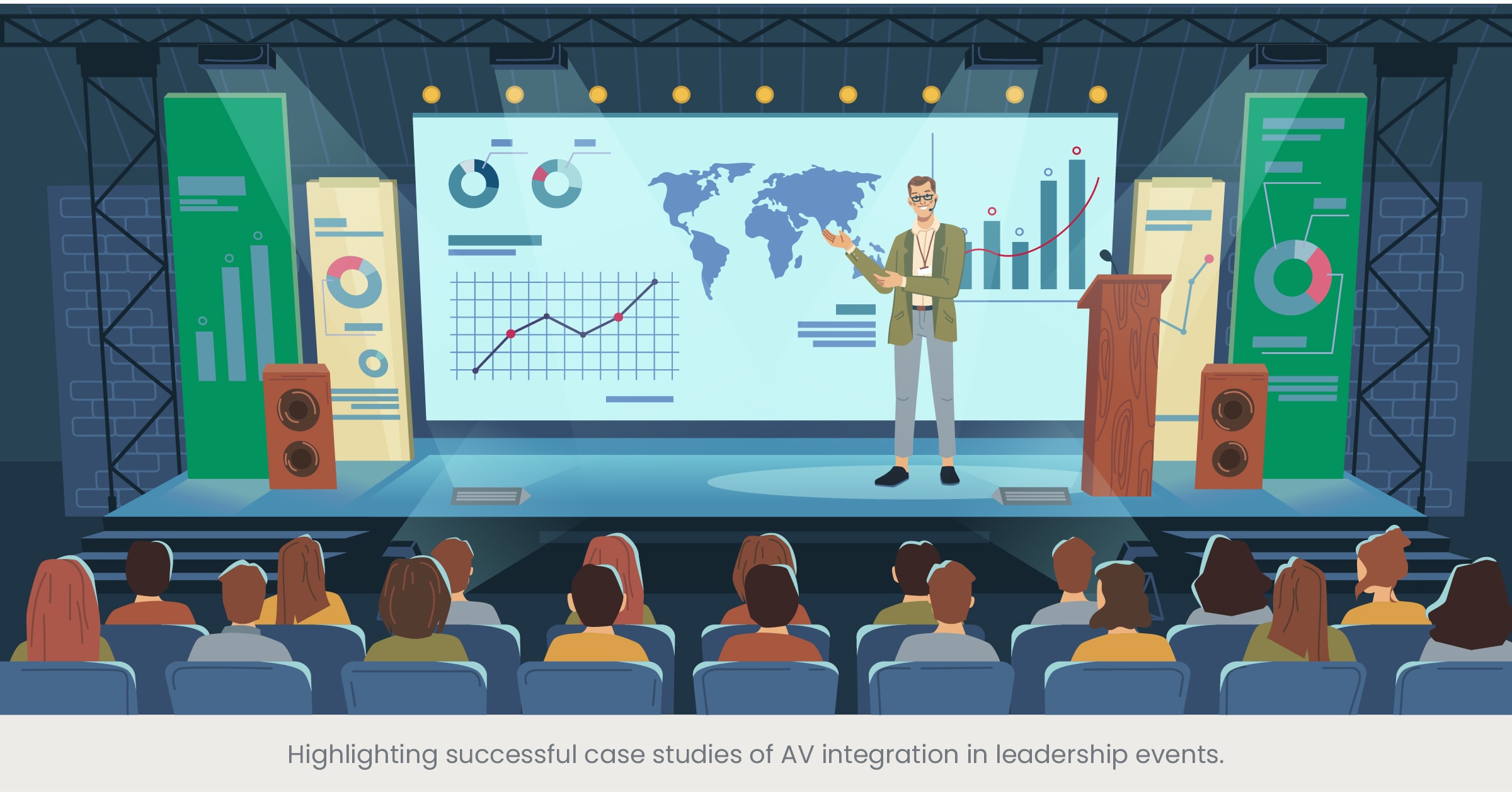
The Power of AV Integration in Leadership Events
Highlighting successful case studies of AV integration in leadership events demonstrates the impact and effectiveness of using audio-visual content in presentations. CEO Audio Visual Content can transform standard presentations into engaging, dynamic experiences with new content that captivate audiences and reinforce key messages. By examining how leading organizations have utilized AV content, we can understand the strategies that contribute to successful leadership presentations.
Deep Dive into Case Studies
One notable example of successful AV integration is Apple’s product launch events. These events are renowned for their seamless blend of high-quality video content, professional audio, and live demonstrations. During these presentations, Apple effectively uses AV content to showcase new products, highlight their features, and demonstrate real-world applications. The use of synchronized visuals and audio ensures that the audience remains engaged and can easily follow along with the presentation.
Another example is TED Talks, which are globally recognized for their high production values and impactful delivery. TED integrates professional audio, high-definition video, and compelling visuals to enhance the speaker's message. This approach ensures that the talks they produce are not only informative but also memorable. The combination of AV elements helps to convey complex ideas in an accessible and engaging manner.
Practical Applications and Trends
In the corporate world, companies like Microsoft and IBM have also embraced AV integration in their leadership presentations. At Microsoft’s annual Ignite conference, keynote sessions utilize a mix of live video, pre-recorded segments, and interactive demonstrations. This blend of AV content keeps the audience engaged and provides a comprehensive understanding of the topics discussed. Similarly, IBM uses AV content during its Think conference to illustrate technological advancements and strategic initiatives, ensuring that the presentations are both informative and visually appealing.
References and Supporting Evidence
Research supports the effectiveness of AV integration in enhancing leadership presentations. According to a report by Wainhouse Research, video content in presentations can increase audience engagement by up to 80%. Another study by Cisco highlights that video will account for 82% of all IP traffic by 2022, underscoring its growing importance in communication. These findings emphasize the value of integrating audio-visual content into presentations, validating the strategies employed by leading companies.
Exploring Options for Live Streaming Content During Presentations
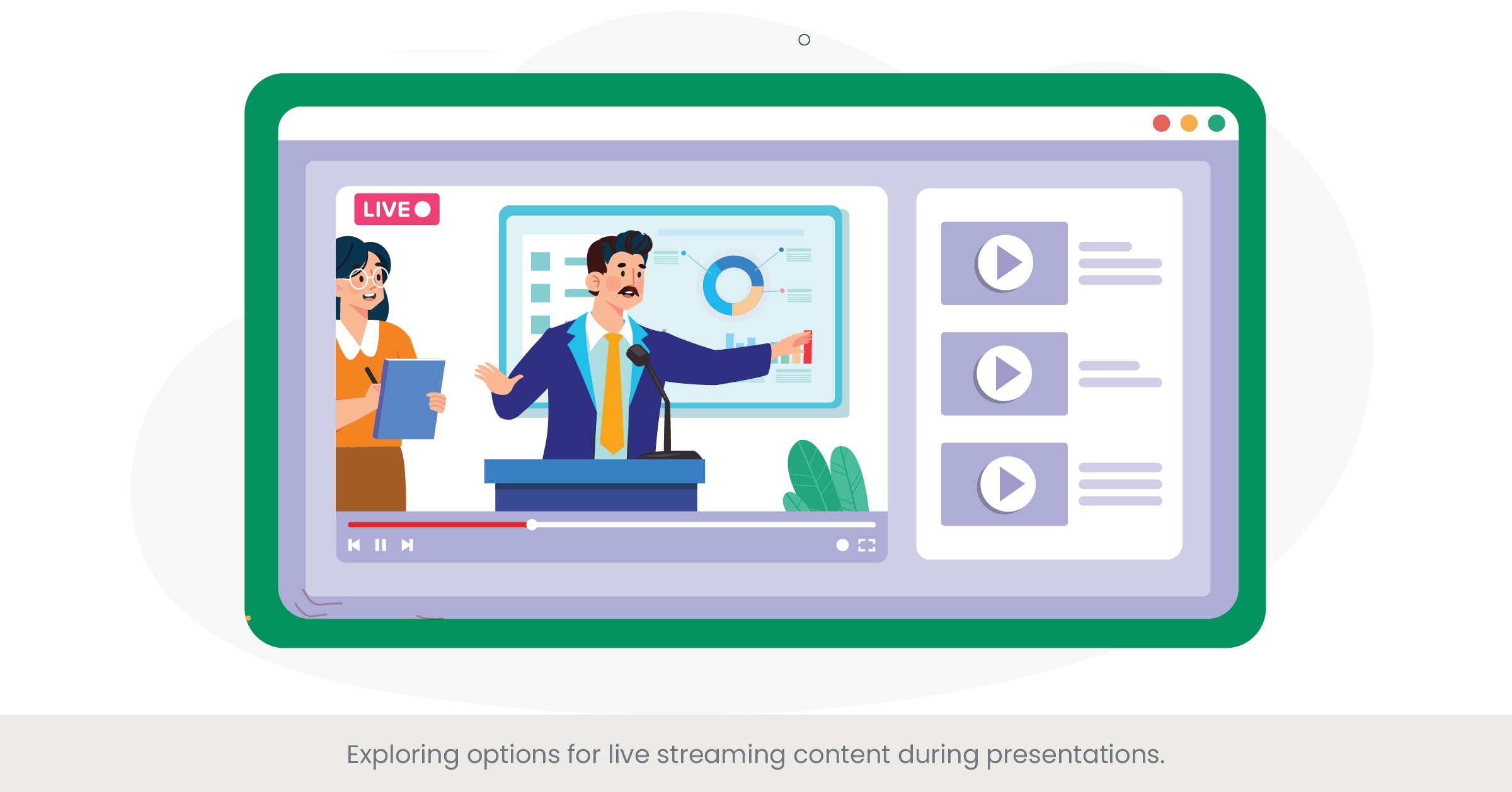
The Growing Importance of Live Streaming
Live streaming has become an essential tool for leadership presentations, allowing companies to reach a broader audience in real-time. CEO Audio Visual Content, when live-streamed, can enhance engagement by providing an interactive and immediate connection with the audience. Live streaming enables organizations to share their messages globally, ensuring that key stakeholders, including employees, channel partners, and consumers, can participate in important events regardless of their location.
Understanding Live Streaming Technologies
The technology behind live streaming involves capturing audio and video content in real-time and broadcasting it over the internet. Various platforms such as YouTube Live, Facebook Live, LinkedIn Live, and dedicated business solutions like Zoom and Microsoft Teams offer robust live streaming capabilities. These platforms provide features such as audience interaction through comments and Q&A, real-time analytics, and integration with other digital tools. A COO Presentation Design Expert can help in selecting the right platform and ensuring the technical setup is optimized for smooth streaming.
Practical Applications and Real-World Examples
Many companies successfully use live streaming to expand and enhance their leadership presentations. For example, Salesforce’s Dreamforce conference utilizes live streaming to reach thousands of participants worldwide. The company broadcasts keynotes, breakout sessions, and panel discussions, ensuring that the global audience can access valuable content live. Another example is Google’s annual I/O developer conference, where live streaming allows developers around the world to engage with new product announcements and technical sessions in real-time. These events leverage high-quality video and audio to create an immersive experience, similar to attending in person.
References and Supporting Evidence
Research highlights the effectiveness of live streaming for engaging broader audiences. According to a report by Livestream, 80% of audiences prefer to watch live video from a brand rather than read a blog, podcast, and 82% prefer live video from a brand to social posts. Additionally, a study by Vimeo indicates that live streaming can increase audience retention by 47% compared to pre-recorded videos. These statistics underline the growing importance of live streaming in corporate communications, emphasizing its role in enhancing audience engagement and expanding reach.
Discussing the Technical Setup and Support for AV Content
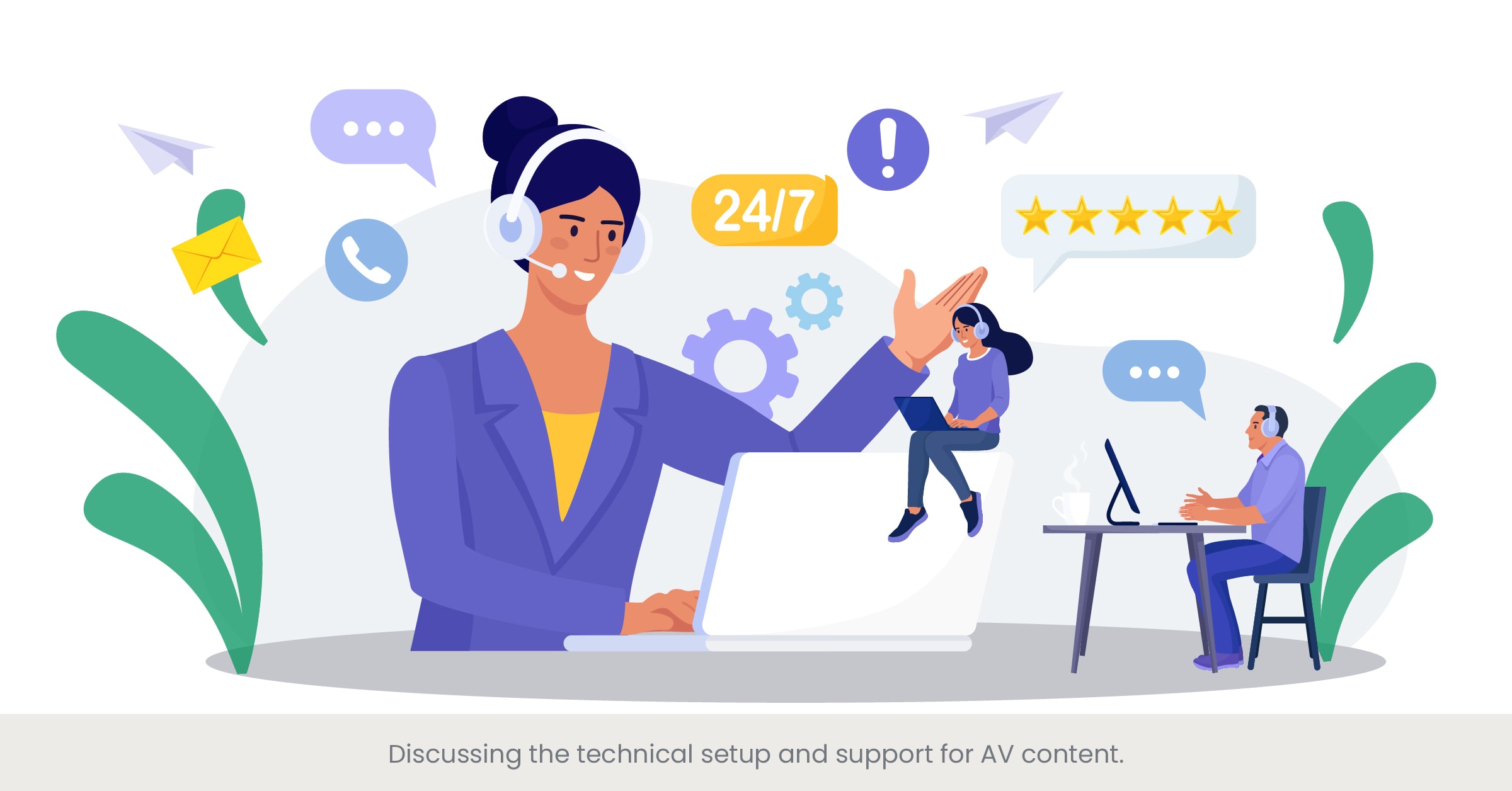
The Importance of Technical Setup for AV Content
The technical setup for audio-visual (AV) content in leadership presentations is crucial for ensuring a smooth and professional delivery. A robust technical setup involves high-quality equipment, reliable software, and expert support to handle any issues that may arise during the presentation. CEO Audio Visual Content must be presented flawlessly to maintain audience engagement and credibility. By focusing on the technical aspects, COOs can ensure that their presentations are both visually and audibly impressive.
Key Components of AV Technical Setup
A successful AV setup includes several key components. High-definition cameras and professional-grade microphones are essential for capturing clear video and audio. Lighting equipment is also critical to ensure that the visuals are sharp and well-lit. Additionally, reliable streaming software and platforms, such as Zoom, Microsoft Teams, or specialized streaming services, are necessary for broadcasting the presentation live. Expert support staff should be on hand to manage the equipment, monitor the stream, and troubleshoot any technical issues. This setup ensures that the presentation runs smoothly and any potential disruptions are quickly addressed.
Practical Applications and Industry Examples
In practice, companies like Amazon and Microsoft invest heavily in their AV setups for major events. For instance, during Amazon’s annual shareholder meetings, the company uses multiple cameras, professional lighting, and high-quality audio equipment to ensure that every aspect of the presentation is clear and engaging. Microsoft’s Ignite conference also showcases a sophisticated AV setup, with dedicated technical teams managing live streams, interactive sessions, and high-definition video presentations. These setups not only enhance the viewing experience but also ensure that the content is delivered without any technical hitches.
References and Supporting Evidence
Research underscores the importance of a strong technical setup for AV content. According to a report by TechSmith, 75% of people are more likely to listen and stay engaged with a presentation that has high-quality video and audio. Furthermore, a study by Wainhouse Research indicates that 67% of viewers believe that high-quality AV content significantly impacts their overall experience of an online event. These findings highlight the necessity of investing in the right technical setup and support for leadership presentations, ensuring that the delivery is professional and engaging.
Evaluating the Effectiveness of Different Types of AV Content
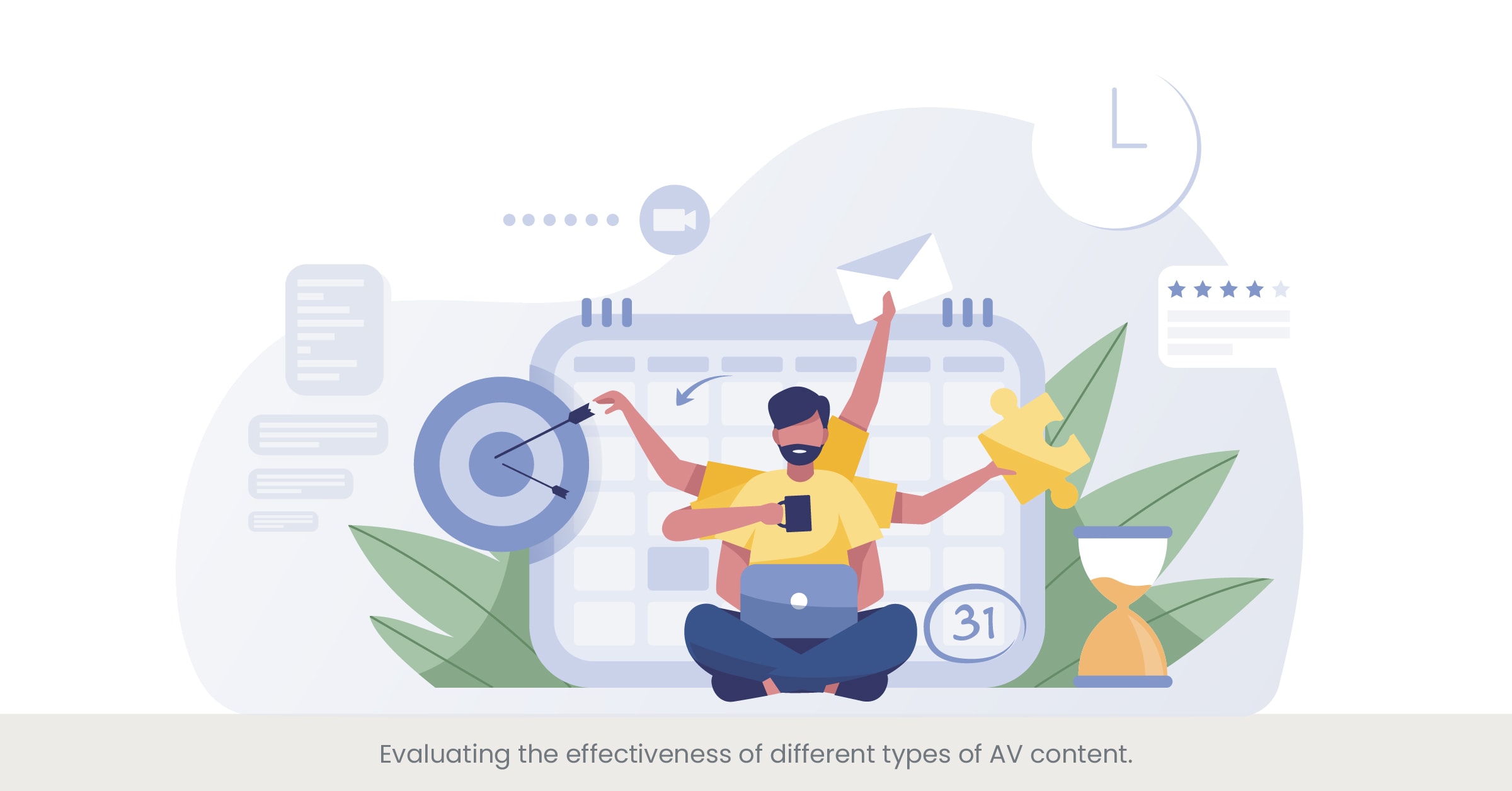
Assessing Various AV Content Types for Presentations
Evaluating the effectiveness of different types of audio-visual (AV) content is essential for creating impactful leadership presentations. CEO Audio Visual Content encompasses a wide range of media, including video clips, animations, infographics, and interactive elements. Each type of content serves a different purpose and can enhance the presentation in unique ways. By understanding the strengths and applications of various AV content types, COOs can select the most appropriate formats to convey their messages effectively.
Deep Dive into AV Content Types
Different types of AV content offer distinct benefits. Video clips, for example, are highly effective for storytelling and demonstrating real-life applications. They can capture attention quickly and convey complex information succinctly. Animations are useful for explaining abstract concepts and processes, providing a visual representation that can simplify understanding. Infographics present data in a visually appealing and easy-to-digest format, making it easier for the audience to grasp key statistics and trends. Interactive elements, such as live polls and Q&A sessions, engage the audience actively, making the presentation more dynamic and participatory.
Practical Applications and Real-World Examples
Real-world applications demonstrate the effectiveness of various AV content types in leadership presentations. For instance, at Apple's product launches, video clips showcasing product features and customer testimonials create a compelling narrative that resonates with the audience. In educational seminars, animations are often used to illustrate complex scientific processes, making them accessible to a broader audience. Infographics are widely used in corporate presentations to present financial data and market analysis, providing a clear and concise overview of key metrics. Interactive elements are a staple in webinars and virtual conferences, allowing participants to engage directly with the presenters and contribute to the discussion.
References and Supporting Evidence
Research supports the effectiveness of using diverse AV content types in presentations. According to a study by the University of Minnesota, presentations that incorporate visual aids are 43% more effective in persuading audiences compared to those without. A report by the Content Marketing Institute found that videos are the most engaging type of content, with 72% of consumers preferring to learn about a product or service through video. Additionally, a study by Adobe highlights that interactive content can increase engagement rates by up to 50%. These findings emphasize the value of using a variety of AV content types to enhance leadership presentations.
Planning for Backup Solutions in Case of AV Failures
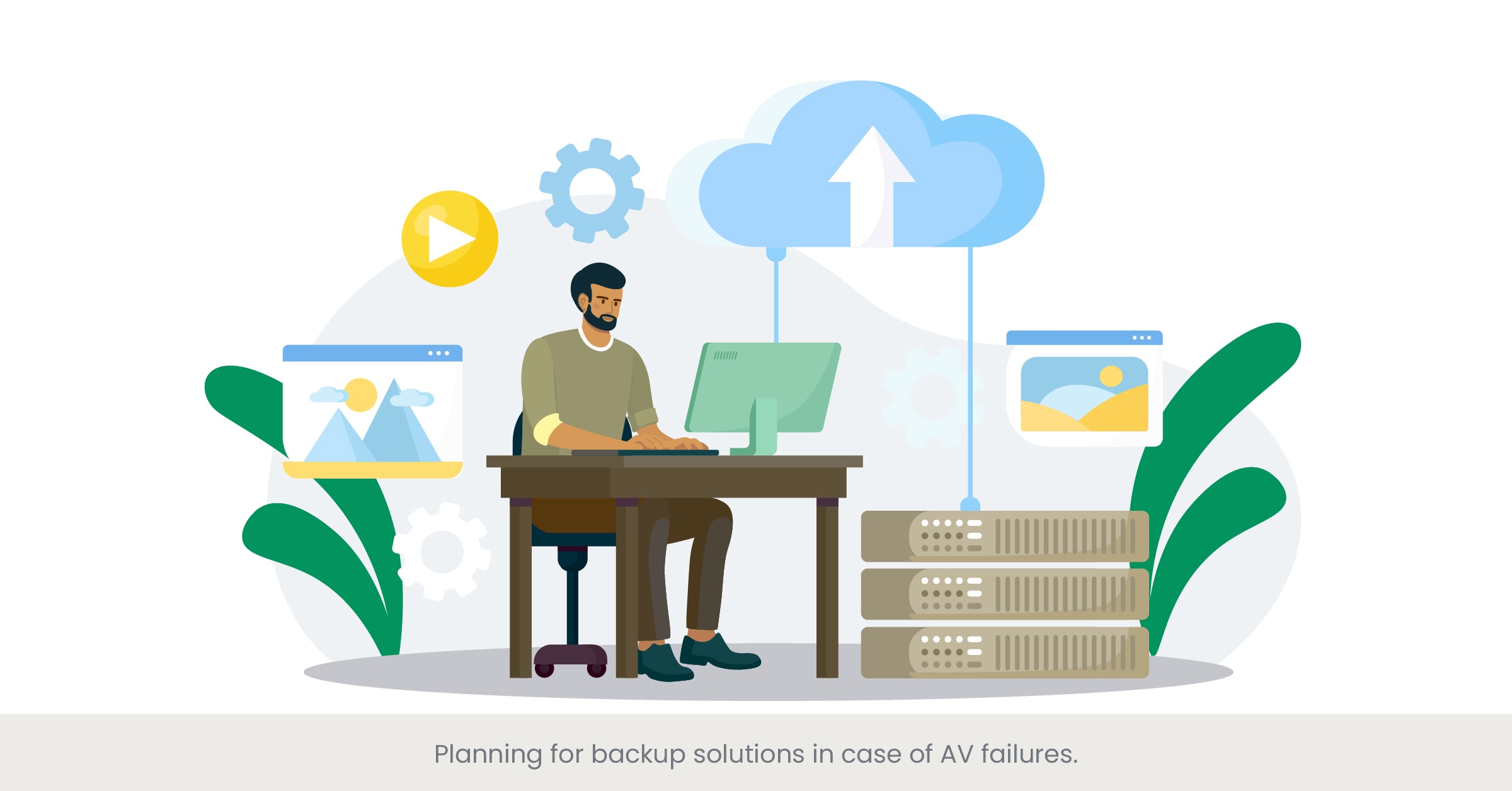
The Importance of Backup Solutions for AV Content
Planning for backup solutions is a critical component of ensuring the success of leadership presentations, particularly those that heavily rely on audio-visual (AV) content. AV failures can disrupt the flow of a presentation and diminish its impact, but having contingency plans in place can mitigate these risks. CEO Audio Visual Content must be supported by robust backup systems to maintain professionalism and keep the team and presentation on track despite technical difficulties.
Developing a Comprehensive Backup Plan
A comprehensive backup plan for AV content involves several key elements. Firstly, duplicate copies of all presentation materials, including videos, slides, and audio files, should be stored on multiple devices such as USB drives, external hard drives, and cloud storage platforms. This ensures that if one source fails, another can be quickly accessed. Secondly, having alternative presentation methods, such as printed handouts or simplified slide decks that do not rely on AV components, can serve as a fallback. Additionally, employing a dual setup with redundant equipment—such as two projectors, multiple microphones, and backup laptops—can provide immediate alternatives in case of hardware failure. Engaging professional presentation services to manage and oversee these backups can further ensure that all contingencies are covered.
Practical Applications and Industry Examples
In practice, many organizations have successfully implemented backup solutions for their AV content. For instance, during high-stakes events like the annual general meetings of Fortune 500 companies, AV teams are equipped with duplicate sets of equipment and multiple copies of all digital files. Companies like Microsoft and IBM often use dual streaming setups during their virtual conferences, ensuring that if one feed fails, the other can take over seamlessly. Another example is in the entertainment industry, where live events, such as the Oscars, have extensive backup plans, including spare microphones, additional lighting rigs, and multiple video feeds, to ensure the show continues without interruption despite any technical issues.
References and Supporting Evidence
Research highlights the importance of having backup solutions for AV content. According to a report by Event Manager Blog, 58% of event professionals experience technical issues during events, underscoring the need for robust backup plans. A study by Frost & Sullivan found that businesses with contingency plans for AV failures experience 40% fewer disruptions in their sales and presentations. These statistics underscore the necessity of preparing for potential AV issues, emphasizing the role of a COO Presentation Design Expert in ensuring that backup solutions are in place.
Ensuring Accessibility in AV Presentations for All Audience Members

The Importance of Accessibility in AV Presentations
Ensuring accessibility in audio-visual (AV) presentations is vital for reaching all audience members, including those with disabilities. Accessibility enhances the inclusivity and effectiveness of leadership presentations by providing equal access to information. CEO Audio Visual Content should be designed with accessibility in mind, ensuring that all participants can engage with the content regardless of their physical or cognitive abilities. This commitment not only broadens the audience but also reflects a company's dedication to diversity and inclusion.
Techniques for Enhancing Accessibility
Several techniques can be employed to enhance accessibility in AV presentations. One essential method is to provide closed captions and subtitles for all video content, which benefits individuals who are deaf or hard of hearing. Additionally, offering transcripts of the audio content ensures that those with hearing impairments or learning disabilities can follow along. Using high-contrast text and clear, readable fonts helps those with visual impairments or dyslexia. Interactive elements, such as live Q&A sessions, should include options for text-based responses to accommodate different communication preferences. Professional presentation services can assist in implementing these accessibility features, ensuring that the content is accessible to everyone.
Practical Applications and Real-World Examples
Incorporating accessibility features into presentations is becoming standard practice among leading organizations. For example, during its annual developer conference, Google provides closed captions and sign language interpreters to ensure that all attendees can access the content. Microsoft includes accessibility features such as screen reader compatibility and high-contrast themes in its presentations, catering to individuals with visual impairments. These companies set an example by prioritizing accessibility, demonstrating that inclusive design is not only achievable but also beneficial for engaging a broader audience.
References and Supporting Evidence
Research underscores the importance of accessibility in enhancing the reach and impact of presentations. According to a study by the World Health Organization, over 1 billion people, or about 15% of the world's population, experience some form of disability. A report by the Web Accessibility Initiative highlights that accessible content can improve user experience for everyone, not just those with disabilities. Furthermore, a study by Adobe found that 60% of users are more likely to engage with content that includes accessibility features such as captions and transcripts. These findings emphasize the value of ensuring accessibility in AV presentations, highlighting the role of a COO Presentation Design Expert in implementing these features effectively.
Offering Guidelines for the Ethical Use of Multimedia Content
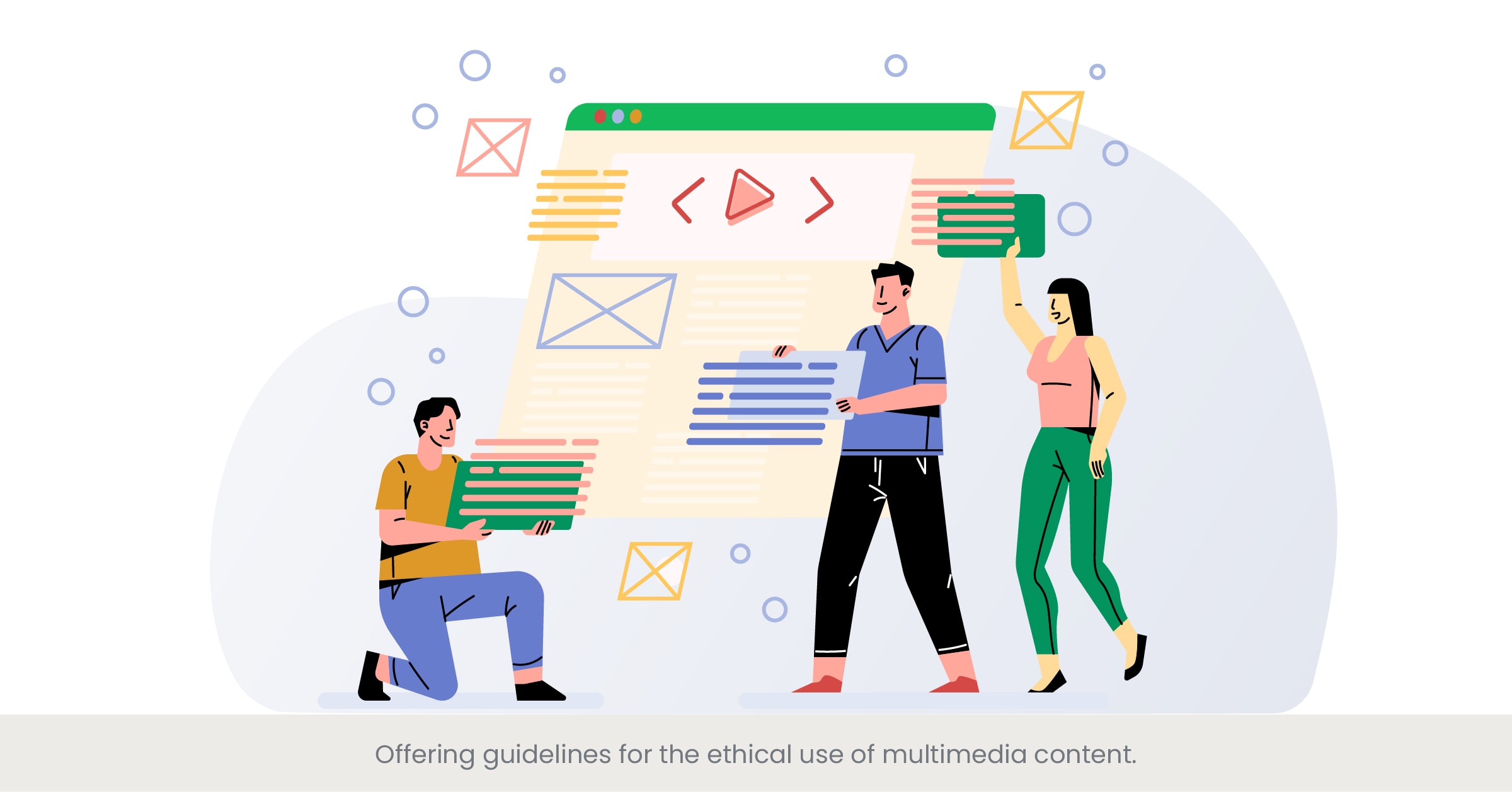
The Importance of Ethics in Multimedia Content
The ethical use of multimedia content in leadership presentations is crucial for maintaining credibility and trust. CEO Audio Visual Content must adhere to ethical standards to ensure that all materials are used responsibly and respect intellectual property rights. By following ethical guidelines, COOs can avoid legal issues, uphold the company’s reputation, and demonstrate integrity in their communications. This commitment to ethical practices is essential for fostering trust with stakeholders, including employees, clients, and the broader audience.
Key Ethical Considerations
There are several key considerations for the ethical use of multimedia content. First and foremost, always obtain proper permissions and licenses for any third-party content used in presentations. This includes images, videos, music, and other media elements. Attribution is also crucial; always credit the original creators of the content. Additionally, be mindful of the context in which multimedia content is presented to avoid misrepresentation or cultural insensitivity. Ensuring that all content is accurate and not misleading is essential for maintaining ethical standards. Engaging professional presentation services can help ensure compliance with these ethical guidelines.
Practical Applications and Real-World Examples
Many organizations demonstrate the ethical use of multimedia content in their presentations. For example, educational institutions like Harvard and Stanford provide detailed citations and attributions for all multimedia elements used in their online courses and lectures. This practice not only respects intellectual property rights but also sets a standard for academic integrity. In the corporate world, companies like IBM and Microsoft have strict policies regarding the use of multimedia content, ensuring that all materials are properly licensed and credited. These organizations lead by example, showing that ethical practices are integral to professional and responsible communication.
References and Supporting Evidence
Research supports the importance of ethical practices in the use of multimedia content. According to a report by the International Association for the Protection of Intellectual Property, improper use of multimedia content can lead to significant legal and financial repercussions. A study by the Center for Media and Social Impact found that ethical use of content can enhance an organization’s reputation and build trust with its audience. Additionally, a report by the American Bar Association highlights that clear attribution and proper licensing are critical components of ethical multimedia use. These findings underscore the necessity of adhering to ethical guidelines in CEO Audio Visual Content, emphasizing the role of a COO Presentation Design Expert in ensuring ethical compliance.
Frequently Asked Questions (FAQs)
1. What is an example of audio visual content?
Audio visual content includes a variety of media formats that combine sound and visual elements. Examples include videos, films, webinars, podcasts with visual components, and animated presentations. A common example would be a corporate video that incorporates background music, voice-over narration, and visual slides or footage to convey a message or tell a story.
2. What does an audio visual director do?
An audio visual director oversees the production and integration of audio and visual components for events, presentations, and media projects. Their responsibilities include planning and coordinating AV setups, managing technical staff, ensuring high-quality sound and visuals, and troubleshooting any technical issues during live events. They play a critical role in creating engaging and seamless multimedia experiences.
3. What is the focus of an audio visual company?
An audio visual company provides services related to the creation, production, and management of audio and visual content. These companies offer a range of services, including AV equipment rental, event production, video production, sound engineering, and multimedia presentations. They cater to various industries such as corporate, education, entertainment, and hospitality.
4. What does AV stand for in audio visual?
AV stands for Audio Visual. It refers to the use of both sound (audio) and visual components in various forms of media and communication. AV technology is commonly used in presentations, films, television news broadcasts, video conferencing, and live events to enhance the delivery of information and engage the audience.
5. What are examples of audiovisual content?
Examples of audiovisual content include:
- Educational videos and tutorials
- Corporate training videos
- Webinars and live-streamed events
- Podcasts with accompanying visual slides
- Marketing videos and advertisements
- Documentaries and short films
- Animated explainer videos
6. What is the meaning of audio visual content?
Audio visual content refers to any type of media that combines both sound and visual elements to convey information or tell listeners a story. This content format leverages the synergistic effect of auditory and visual stimuli to engage audiences more effectively, making it a powerful tool for communication, education, and entertainment.
7. What is written and visual content?
Written and visual content refers to media that includes text and images to convey information. This can include articles, blogs, infographics, social media channels, posts, and presentations that use a combination of written words and visual elements like photos, illustrations, charts, and graphs to enhance the message and engage the audience.
8. What is the audio visual mode medium of communication?
The audio visual mode of communication combines sound and visual elements to deliver a message or share information. This mode is highly effective for marketers because it engages multiple senses, making it easier for the audience to understand and retain the information. Examples include videos, live presentations, and interactive multimedia content.
9. How do you ensure accessibility in AV presentations?
To ensure accessibility in AV presentations:
- Provide closed captions and subtitles for all video content.
- Offer transcripts of audio content.
- Use high-contrast text and clear fonts for readability.
- Include sign language interpretation if possible.
- Ensure compatibility with screen readers.
- Provide alternative text for images and visual elements. These steps help make presentations accessible to individuals with disabilities, ensuring equal access to information.
10. Why is it important to have backup solutions for AV content?
Backup solutions are crucial for AV content to prevent disruptions during presentations. Technical failures can occur unexpectedly, and having backup copies of the film, all materials, alternative equipment, and contingency plans ensures that the presentation can continue smoothly. This preparedness helps maintain professionalism and minimizes the impact of any technical issues on the audience's experience.



%20(1).jpg)
%20(1).jpg)
